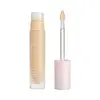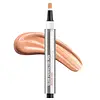What's inside
What's inside
 Key Ingredients
Key Ingredients

 Benefits
Benefits

 Concerns
Concerns

 Ingredients Side-by-side
Ingredients Side-by-side

Water
Skin ConditioningSynthetic Fluorphlogopite
Dimethicone
EmollientIsononyl Isononanoate
EmollientIsohexadecane
EmollientButylene Glycol
HumectantGlycerin
HumectantDiisostearyl Malate
EmollientCetyl PEG/PPG-10/1 Dimethicone
EmulsifyingCellulose
AbsorbentPolyglyceryl-4 Isostearate
EmulsifyingPhenoxyethanol
PreservativeSodium Chloride
MaskingDisteardimonium Hectorite
StabilisingCaprylic/Capric Triglyceride
MaskingPotassium Sorbate
PreservativeSodium Dehydroacetate
PreservativeAlcohol Denat.
AntimicrobialTriethoxycaprylylsilane
C20-24 Olefin
Skin ConditioningSilica Dimethyl Silylate
EmollientAlumina
AbrasiveTocopheryl Acetate
AntioxidantPanthenol
Skin ConditioningEscin
TonicRuscus Aculeatus Root Extract
AstringentAmmonium Glycyrrhizate
MaskingCentella Asiatica Leaf Extract
Skin ConditioningRosa Hybrid Flower Extract
Skin ConditioningHydrolyzed Yeast Protein
Skin ConditioningCalendula Officinalis Flower Extract
MaskingSodium Citrate
BufferingPentaerythrityl Tetra-Di-T-Butyl Hydroxyhydrocinnamate
AntioxidantCI 77891
Cosmetic ColorantIron Oxides
Water, Synthetic Fluorphlogopite, Dimethicone, Isononyl Isononanoate, Isohexadecane, Butylene Glycol, Glycerin, Diisostearyl Malate, Cetyl PEG/PPG-10/1 Dimethicone, Cellulose, Polyglyceryl-4 Isostearate, Phenoxyethanol, Sodium Chloride, Disteardimonium Hectorite, Caprylic/Capric Triglyceride, Potassium Sorbate, Sodium Dehydroacetate, Alcohol Denat., Triethoxycaprylylsilane, C20-24 Olefin, Silica Dimethyl Silylate, Alumina, Tocopheryl Acetate, Panthenol, Escin, Ruscus Aculeatus Root Extract, Ammonium Glycyrrhizate, Centella Asiatica Leaf Extract, Rosa Hybrid Flower Extract, Hydrolyzed Yeast Protein, Calendula Officinalis Flower Extract, Sodium Citrate, Pentaerythrityl Tetra-Di-T-Butyl Hydroxyhydrocinnamate, CI 77891, Iron Oxides
Water
Skin ConditioningGlycerin
HumectantMethyl Trimethicone
Skin ConditioningHydrogenated Polyisobutene
EmollientDimethicone
EmollientTrimethylsiloxysilicate
EmollientButylene Glycol Dicaprylate/Dicaprate
EmollientPhenyl Trimethicone
Skin ConditioningPentylene Glycol
Skin ConditioningLauryl PEG-10 Tris(Trimethylsiloxy)Silylethyl Dimethicone
EmulsifyingTocopheryl Acetate
AntioxidantIsododecane
EmollientCetyl PEG/PPG-10/1 Dimethicone
EmulsifyingPolyphenylsilsesquioxane
Panthenol
Skin ConditioningMagnesium Sulfate
Silica
AbrasiveDisteardimonium Hectorite
StabilisingDimethicone/Vinyl Dimethicone Crosspolymer
Skin ConditioningTriethoxycaprylylsilane
Aluminum Hydroxide
EmollientCaprylyl Glycol
EmollientGlyceryl Caprylate
EmollientTrisodium Ethylenediamine Disuccinate
Titanium Dioxide
Cosmetic ColorantMica
Cosmetic ColorantIron Oxides
Water, Glycerin, Methyl Trimethicone, Hydrogenated Polyisobutene, Dimethicone, Trimethylsiloxysilicate, Butylene Glycol Dicaprylate/Dicaprate, Phenyl Trimethicone, Pentylene Glycol, Lauryl PEG-10 Tris(Trimethylsiloxy)Silylethyl Dimethicone, Tocopheryl Acetate, Isododecane, Cetyl PEG/PPG-10/1 Dimethicone, Polyphenylsilsesquioxane, Panthenol, Magnesium Sulfate, Silica, Disteardimonium Hectorite, Dimethicone/Vinyl Dimethicone Crosspolymer, Triethoxycaprylylsilane, Aluminum Hydroxide, Caprylyl Glycol, Glyceryl Caprylate, Trisodium Ethylenediamine Disuccinate, Titanium Dioxide, Mica, Iron Oxides
 Reviews
Reviews

Ingredients Explained
These ingredients are found in both products.
Ingredients higher up in an ingredient list are typically present in a larger amount.
This ingredient is a high molecular weight silicone. It has emulsifying and skin conditioning properties.
Dimethicone is a type of synthetic silicone created from natural materials such as quartz.
What it does:
Dimethicone comes in different viscosities:
Depending on the viscosity, dimethicone has different properties.
Ingredients lists don't always show which type is used, so we recommend reaching out to the brand if you have questions about the viscosity.
This ingredient is unlikely to cause irritation because it does not get absorbed into skin. However, people with silicone allergies should be careful about using this ingredient.
Note: Dimethicone may contribute to pilling. This is because it is not oil or water soluble, so pilling may occur when layered with products. When mixed with heavy oils in a formula, the outcome is also quite greasy.
Learn more about DimethiconeDisteardimonium Hectorite comes from the clay mineral named hectorite. It is used to add thickness to a product.
It can also help stabilize a product by helping to disperse other ingredients.
Hectorite is a rare, white clay mineral.
Learn more about Disteardimonium HectoriteGlycerin is already naturally found in your skin. It helps moisturize and protect your skin.
A study from 2016 found glycerin to be more effective as a humectant than AHAs and hyaluronic acid.
As a humectant, it helps the skin stay hydrated by pulling moisture to your skin. The low molecular weight of glycerin allows it to pull moisture into the deeper layers of your skin.
Hydrated skin improves your skin barrier; Your skin barrier helps protect against irritants and bacteria.
Glycerin has also been found to have antimicrobial and antiviral properties. Due to these properties, glycerin is often used in wound and burn treatments.
In cosmetics, glycerin is usually derived from plants such as soybean or palm. However, it can also be sourced from animals, such as tallow or animal fat.
This ingredient is organic, colorless, odorless, and non-toxic.
Glycerin is the name for this ingredient in American English. British English uses Glycerol/Glycerine.
Learn more about GlycerinPanthenol is a common ingredient that helps hydrate and soothe the skin. It is found naturally in our skin and hair.
There are two forms of panthenol: D and L.
D-panthenol is also known as dexpanthenol. Most cosmetics use dexpanthenol or a mixture of D and L-panthenol.
Panthenol is famous due to its ability to go deeper into the skin's layers. Using this ingredient has numerous pros (and no cons):
Like hyaluronic acid, panthenol is a humectant. Humectants are able to bind and hold large amounts of water to keep skin hydrated.
This ingredient works well for wound healing. It works by increasing tissue in the wound and helps close open wounds.
Once oxidized, panthenol converts to pantothenic acid. Panthothenic acid is found in all living cells.
This ingredient is also referred to as pro-vitamin B5.
Learn more about PanthenolTocopheryl Acetate is AKA Vitamin E. It is an antioxidant and protects your skin from free radicals. Free radicals damage the skin by breaking down collagen.
One study found using Tocopheryl Acetate with Vitamin C decreased the number of sunburned cells.
Tocopheryl Acetate is commonly found in both skincare and dietary supplements.
Learn more about Tocopheryl AcetateTriethoxycaprylylsilane is a silicone used to bind and stabilize ingredients.
As an emulsifier, it helps prevent ingredients from separating. This can help elongate the shelf life of products.
Triethoxycaprylylsilane is often used to coat mineral sunscreens ingredients to help give a better feel. It also helps reduce oxidative stress in sunscreens.
Learn more about TriethoxycaprylylsilaneWater. It's the most common cosmetic ingredient of all. You'll usually see it at the top of ingredient lists, meaning that it makes up the largest part of the product.
So why is it so popular? Water most often acts as a solvent - this means that it helps dissolve other ingredients into the formulation.
You'll also recognize water as that liquid we all need to stay alive. If you see this, drink a glass of water. Stay hydrated!
Learn more about WaterThis ingredient is a combination of red, black, and yellow iron oxide pigments. This combination of colors is usually found in foundation, because it results in a "skin" color.